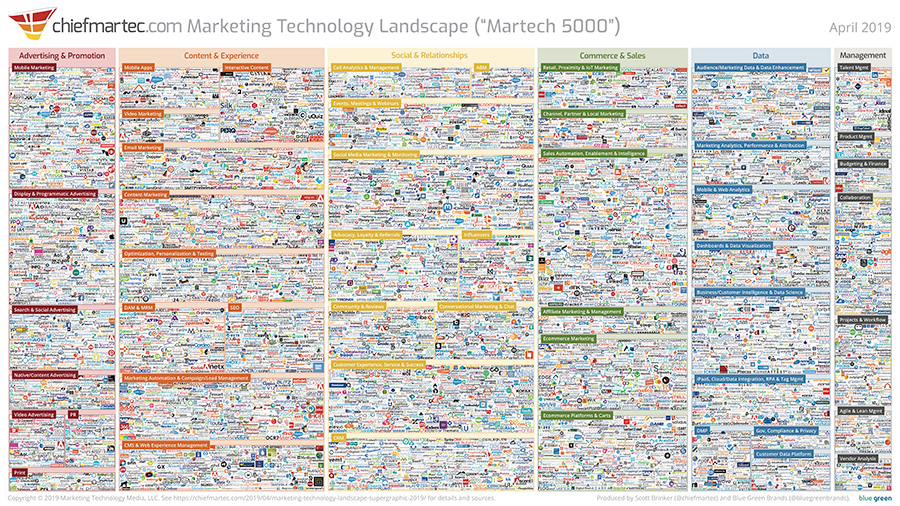I’ve seen it, you’ve seen it, we’ve all probably seen the annual horrifying awe-inspiring MarTech landscape “supergraphic” from the Chief Marketing Technologist blog.
This year’s version includes more than 7,000 (yes, that many zeros) tools, solutions, and platforms vying for the chance to make you a better marketer. Content alone earns itself an entire column in this monstrosity of a diagram (it’s in the orange), and content marketing (the fourth box down) gets its own jam-packed section. I point this out to say that any mental gymnastics you’ve done in the last 10 seconds to convince yourself it’s not that bad for the type of software you’re looking for can officially be rendered meaningless.
I’m not trying to be harsh. It’s a simple truth: The MarTech landscape is a messy one, and content technology is no exception. What’s a marketer to do?
Well,
Don’t: Spend the next several months going through each of these options until you finally throw up your hands and sign with whoever popped up in your Google search first.
Do: Set out on your search with intentionality so you can find the vendor best suited to your needs.
But before you do anything else, tackle these three things:
1. Decide: Point Solution or CMP?
First of all, what am I talking about? Let’s get some definitions out of the way:
Content marketing platforms (CMPs): CMPs manage the entirety of the content lifecycle, meaning they’re your one-stop-shop from planning, production, distribution, and analysis. Their broad coverage means they can act as your ever-elusive single source of truth that keeps content from turning into chaos. They support content marketers, of course, but they are also vital to the work of many tangential stakeholders like demand generation and field marketers, who use and adapt content for their needs, as well as customer-facing teams, who use content throughout the full content lifecycle. By uniting these disparate business stakeholders through content, CMPs allow groups to collaborate on, orchestrate, and distribute content.
Point solutions: Much cheaper than CMPs, point solutions usually solve a single aspect (for example, workflows) of the broader content operation you’re running. These can be great in a pinch but are usually most effective for smaller organizations or for those who are integrating tools into an already robust tech stack (anchored by a CMP). The problem with point solutions on their own is that they solve surface-level challenges without getting to the root of the problem.
You’ll need to string multiple point solutions together to imitate the functionality of a CMP, and will likely find it more challenging to centralize work and collaboration in a single place. With a point solution, keep in mind that your up-front savings may evaporate with integration costs down the line.
The type of solution you choose will depend on the size and maturity of your organization, as well as your budget. While point solutions may be easier to sell internally, a CMP will likely have greater impact on the effectiveness of your content operation. Either way, understanding the distinction upfront can help you cut out vendors that don’t match the breadth of your needs.
2. Build the [Right] Buying Group
One of the biggest reasons software purchases go awry is that the group making the decision simply can’t agree. Stuck in a stalemate, and with a hundred other things to do, these committees often splinter, giving up before they’re able to make a choice.
The best way to avoid this sorry state is to involve stakeholders from the start to ensure that everyone’s needs are heard and addressed. Who’s everyone? According to Gartner, today’s average buying group includes somewhere between six and ten people, so get ready to get social. Here’s who you’ll likely want to include:
- The budget holder – Usually a CMO or other executive.
- Users – Those who will be in the software day-to-day, including writers, graphic designers, and project managers.
- Beneficiaries – Sales enablement and other customer-facing teams who want to find and use content more effectively.
- IT/security – Those who will ultimately need to sign off on the purchase.
3. Gather and Prioritize Your Qualifying Questions
Content software spans more than just creation. Here are the kinds of questions anyone vying for your business should be able to answer.
- Configurability and implementation – How will a vendor work with you? What are their biggest limitations and strengths?
- Planning – How will a vendor help you ideate, source inputs, and come together to form and communicate effective content plans?
- Creation – How will a vendor help you deliver on your plans across all your far-flung teams, tools, and channels?
- Activation – How will a vendor help you distribute your content both externally and internally to customer-facing teams?
- Measurement – How will a vendor help you assess return on your content investment?
- Financial security – How will a vendor be able to support you for the long-haul?
- Technical security – How will a vendor keep your information safe?
We’ve detailed more than 70 questions you might want to ask across these categories, as well as why each of them might matter (or not!) to your organization in our new buying guide.
The value of the questions won’t come finding the answers to all of them, but rather in deciding which are most important to you as you speak with sales. You can download your free copy now.



